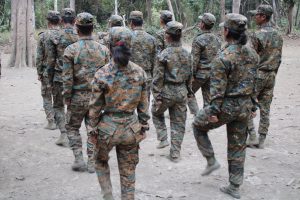Women in Myanmar enjoyed a high degree of freedom and power before the military coup in 1962. Women’s erstwhile status can be gauged from the fact that voting rights were granted to them as early as 1922, which was only four years after the same rights were granted in the United Kingdom. There were many instances of Burmese women occupying top positions during the pre-colonial period. They were active also in the nationalist movement against colonial rule that culminated in independence for the country in 1948.
All these developments notwithstanding, women were barred from participating in local and national decision-making processes after the coup in 1962. Aung San Suu Kyi was a prominent exception, made possible by the fact that she was the daughter of independence leader Aung San.
There was progress toward greater inclusivity during the 10 years of semi-civilian rule from 2011 to 2021, but the deep-rooted conservative mindset that came into being during the dictatorship prevented many women and young people from getting deeply engaged with formal politics.
However, the military’s policies could not extinguish the flame of women’s resistance. After the 1988 uprising, which witnessed many women take to the frontline, more than 500 women were imprisoned because of their political activism. And within days of the coup in 2021, women plunged headlong into the protests. The Sarong Revolution saw them hanging their traditional htamein (skirt) with ropes attached to windows or poles to deter soldiers and policemen. There is a belief in the country that walking underneath women’s clothes will make men lose their special powers; women took this misogynistic superstition and turned it to their advantage.
This was just the beginning of women’s active participation in the resistance movement against the military regime. During the initial months of the protest in 2021, the Gender Equality Network estimated that 70 to 80 percent of Civil Disobedience Movement (CDM) leaders were women. According to the Assistance Association for Political Prisoners (AAPP), which keeps a running tally of civilians arrested or killed by the junta, women comprise almost 40 percent of those arrested.
These episodes served as the trigger for more women across the country and abroad to dive into action to overthrow the State Administration Council (SAC) constituted by the military.

































